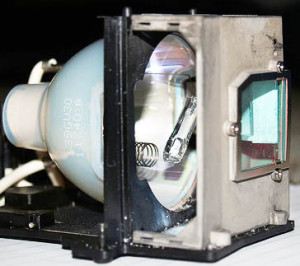7 Tips for spotting counterfeit projector lamps
 Spot the seven signs of counterfeit projector lamps
Spot the seven signs of counterfeit projector lamps
With the popularity of the DLP Projectors and Rear Projector TVs, there’s been an explosion of websites counterfeit projector lamps.
“We have seen a dramatic rise with counterfeit lamps. Unfortunately they are extremely hard to spot,” said Dave Bethell of Genuine Lamps.com
How do you protect yourself from being sold a black market product that may harm your projector? Here are seven telltale signs for spotting counterfeits.
1. Price
The cheapest price for a genuine lamp is at 20% off the manufacturer’s price. This is an industry standard agreed upon by companies creating genuine lamps hybrids and the OEM (Original Equipment Manufacturer). If you come across a projector lamp or RPTV that seems like an incredible bargain—run because it’s a forgery and will cause problems later on.
2. Dodgy Part numbers
It’s easy for the counterfeit companies to simply use the part number as the manufacturer, many don’t bother to even make sure they have the correct number. Look at the manufacturer’s website for the part number and compare it against the one being used by the company offering the incredible bargain. If the two don’t match, don’t buy.
3. Double speak
Statements such as “100% Brand New OEM Equivalent” and “OEM Compatible Lamps” and “guaranteed to be 100% compatible with the factory original” should make you suspicious. These statements are euphemisms for counterfeit lamps created by the bootleg companies in order to trick you into buying and prevent them from being sued. The company is not pretending to be selling anything but fakes they’ve just worded it differently.
4. Difficult to contact
If you’re buying from a place with no direct customer service line, no direct email and no salesperson to contact, then that may also be a sign that the company is selling counterfeit. You should be able to easily contact the company and there should be a clearly outlined return policy.
5. Mislabeling
Black market products often have labeling that looks unprofessional or there is clearly a knockoff label. If you the manufacturers label looks suspicious, check underneath for an original label. Often companies will put a knock-off label over top of their own.
6. No original codes
Check for the original code. Original lamps are stamped with a code identifying each company. See the chart below for more information. If the lamp is missing this code then it’s not adhering to the ANSI standards for bulbs and should be avoided. Codes such a PL or GL are codes used by copy-lamp manufacturers.
| Lamp Name | Code |
| Phillips | UHP |
| Osram | P-VIP |
| Phoenix | SHP |
| Ushio | UMPRD |
| Mitsubishi | VLT |
| Hewlett Packard | L1 |
| IBM | 31 |
| EPSON | ELP |
7. Naked bulbs, no cage
Counterfeit lamps are often sold with no cage just the light bulb. Phillips has authorized MI Technologies to sell their replacement bulbs since this company also manufactures its own cages. It’s this is a rare exception to the rule, however. Most companies selling only light bulbs are selling counterfeits. There are others selling OEM lamps.
Wondering why you should avoid cheap blackmarket counterfeits? Read more:
- Generic DLP Lamps may cost you more in the long run
- Why Generic RPTV lamps cost more
- Consumer Alert to the dangers of RPTV Generic Lamps
- Consumer Alert to the dangers of generic lamps
.

Thanks Jon.
Regards,
Shelagh